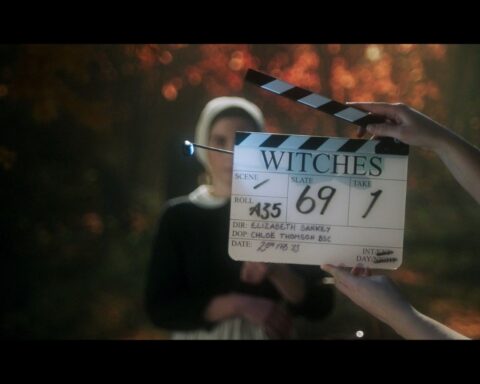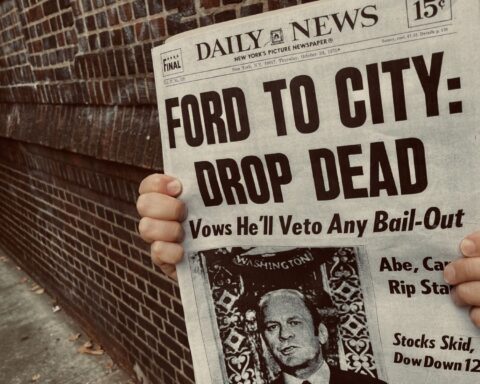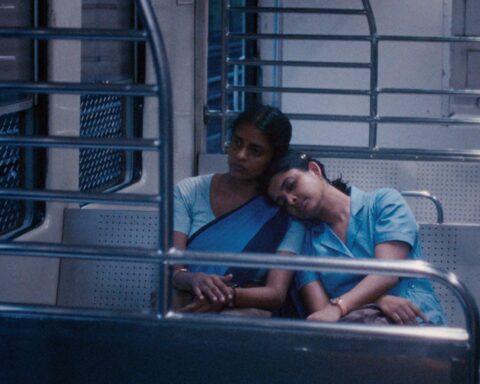The spark of documentary in Atlantic Canada was first lit with the legendary Challenge for Change films shot on Newfoundland’s Fogo Island, introducing a marginalised community to the use of media for the purposes of self-representation. Many of the Fogo films were not intended for wide distribution, but the lyricism of films like The Children of Fogo Island (1967) helped bridge the geographic remoteness of the East Coast to the rest of Canada. For me, however, it is the directness of voice in the less well-known Billy Crane Moves Away (1967) that speaks to the honest vitality of documentary. The film is almost entirely a close-up of a fisherman explaining why financial forces are causing him to relocate for work. Some viewers find Billy’s thick speech difficult to follow. His voice, which follows its own rich poetic rhythm, is weathered by work at sea and reflects conditions of place.
Many men like Billy Crane left remote communities for central Canada, but the activism on Fogo helped rebuild the local economy. These days, it is also based on gentrified tourism. Marcia Connolly and Katherine Knight’s Strange and Familiar: The Architecture of Fogo Island (2015) details the building of an art gallery, hotel and series of artist studios by Fogo-born architect Todd Saunders and the relationship between vernacular patterns of habitation and modernist uses of space. Connolly and Knight previously found success with Pretend Not to See Me (2009), set on the west coast of Newfoundland with performance artist Collette Urban bringing her art into the intimate space of documentary. And in St. John’s, Rosemary House’s Rain, Drizzle and Fog (1998) took pleasure in the rich storytelling tradition of a city located on the inhospitable North Atlantic.
The vernacular is the specificity of language, especially slang that is rooted in place. This is the focus of John Scott’s Scouts Are Cancelled (2007), a film on poet John Stiles, born in the Annapolis Valley region of Nova Scotia but whose poetic voice developed while working dead-end call centre jobs in Toronto. John began his calls asking, “How ya doin’ anight?” This way of keeping boredom at bay resulted in him becoming a top salesman, but it was also the spark of a poetic practice that would echo the farm labour voices of the Valley. It echoes William D. MacGillivray’s Reading Alistair MacLeod (2005), where literary authors read passages from MacLeod’s stories and reflect on the way landscape shapes voice and experience. MacLeod’s fiction is highly influential in Canadian literature, and the stories are primarily set on Cape Breton Island with characters caught between a Gaelic oral tradition and the alienating forces of modernity. The New Brunswick mirror of MacLeod is Living on the Edge: The Poetic Works of Gérald Leblanc (2006) by Rodrigue Jean, on the poet and key figure in the renaissance of Acadian art.
Always fascinated by the roots of cultural practice, MacGillivray wrote and directed the iconic fiction film Life Classes (1987) about Mary Cameron (Jacinta Cormier), who moves from a small town in Cape Breton to Halifax due to the social pressures she faces as an unwed mother. Mary becomes an artist and begins her education as a life-drawing model at the Nova Scotia College of Art and Design where, at around the same time, MacGillivray shot the documentary I Will Not Make Any More Boring Art (1988), the title of a John Baldassari print and the unofficial motto of the school. The documentary explored the unique conditions of this school located in a sleepy town by the ocean that made it, from the 1970s and into the mid-1980s, an unlikely international centre for conceptual art.
The vernacular of south shore Nova Scotia is marked by tire tracks on the highway, and this is transformed into art in Ariella Pahlke’s Burning Rubber (2009). It is a strange inversion of the region’s folk art, a practice documented with humour in Folk Art Found Me (1993), directed by Alex Busby. Speech, voice and labour come together in John Walker’s Men of the Deeps (2003), on the Cape Breton choir made up of coal miners, resonating through song the long oral tradition of underground work. In contrast, Walker’s The Fairy Faith (2000), shot in Cape Breton, on the moors of England and in the Scottish highlands, deals with ways of seeing landscape through imagination, connecting region and storytelling to patterns of migration. Underground mining is dangerous work, but it is more brutal and unforgiving under conditions of capitalist greed where, for example, compromised safety protocols led to the deaths of 26 miners in the explosion of Nova Scotia’s Westray Mine in 1992. Paul Cowan’s Westray (2001) examines the intersection of old-boy politics, greed and precarious work shaping this tragedy.
Westray , Paul Cowan, provided by the National Film Board of Canada
NFB patriarch John Grierson scorned the idea of cinematic regionalism, but the impact of the Fogo films, as tools for political and community engagement and as compelling expressions of cinema verité, helped renew the Board, leading to the opening of production centres throughout the country, including one in Halifax in 1973. This was a period of regional cultural expansion throughout Canada, not just in film but also in publishing, theatre and art.
In film, it was the network of cooperatives nurtured and funded by the Canada Council that fostered local expression. The Atlantic Filmmaker’s Cooperative (AFCOOP) began to take shape over libations at the Seahorse Tavern in Halifax the same year that the NFB came to town. Filmmakers in the region gained valuable experience working with the Board, but an underlying tension grew between those interested in developing a style and approach that they felt to be true to their sense of place and those who wanted to work in the industry and emulate the NFB house style. In St. John’s, the Newfoundland Independent Filmmaker’s Cooperative (NIFCO) was organised in 1975. Cooperatives in New Brunswick and Prince Edward Island were formed in the 1980s, at a remove from the chaos and cultural ferment of the ’70s. These organisations remain important, but the counter-culture vibe has been mostly replaced by administrative order and a membership that leans more toward professional training and calling-card productions.
The filmmaking cooperatives formed out of a basic need for infrastructure at a time when there were few resources for filmmaking, but the spatial dynamics set in motion the burning desire, on the part of filmmakers, to express something of themselves and the places they inhabit. At NIFCO and AFCOOP, the influential work of Swiss-born Cape Breton-based photographer/filmmaker Robert Frank set the tone for early filmmaking in the region. Frank’s verité pictures in his seminal book The Americans (1959) broke all the rules of photography and their grainy texture revealed a truth felt in neglected corners of America. He brought this same spirit to his films, refusing categories such as documentary and urging filmmakers to understand that art is made outside of existing rules. After Frank (2005) is filmmaker Walter Forsyth’s search for the titular father figure but the lesson he learned is that art needs to be made with the influences and conditions of the present, not by the light of a nostalgia for past success.
Another key influence across the modes of documentary and drama in this formative period was Quebec auteur Jean Pierre Lefebvre, who brought to filmmaking a deep sense of place alongside a worldly sophistication. These influences helped legitimise an ideal of cinema at a time before there was any local infrastructure and where the idea of culture was either categorised as craft and nostalgia or as something that could only be made elsewhere. In Newfoundland, this creative energy culminated with The Adventure of Faustus Bidgood (1986). This fiercely independent 10-year production involved the sweat equity of most of the St. John’s art community. It is a fictionfilm, but directors Mike and Andy Jones swear that the flashback scene at a Catholic school, with a teacher dangling a student out of an upper-story window as the boy recites his history lesson, is a pure documentary expression of the trauma, violence and madness of their childhood education.
Geography is structured by systemic patterns of exclusion, as in the case of black settlement on the marginalised lands throughout Nova Scotia. Sylvia Hamilton’s Little Black Schoolhouse (2007) deals with the history of segregated schools in Canada, including the last one to be closed in Guysborough County, Nova Scotia in 1986. Like the more recent discourse on residential schools, this film runs against the grain of Canada’s mythology of multicultural pluralism. Films on Africville, the historic black community of Halifax bulldozed by the city in 1967, include Remember Africville by Shelagh Mackenzie (1991) and Africville: Can’t Stop Now (2009) by Juanita Peters. It’s a story that remains a scar on the urban landscape.
If there is a single image that defines the state’s relationship to Indigenous peoples, it is of a Department of Fisheries and Oceans vessel ramming into a small boat occupied by Mi’kmaq fishermen in Alanis Obomsawin’s Is the Crown At War With Us? (2002). The men from Burnt Church, New Brunswick, were exercising fishing rights clearly affirmed by the Supreme Court. This politics of place is matched by The Spirit of Annie Mae (2002) by Mi’kmaq filmmaker Catherine Martin, on the unresolved murder of activist Annie Mae Pictou Aquash, which connects the conflicts in the region to the broader struggle of A.I.M., the American Indian Movement.
You can buy sushi in most every corner of the planet, but this massive business depends on “the tuna capital of the world” in North Lake, P.E.I., the subject of John Hopkins’ Bluefin (2016). This NFB documentary connects locality to the global flows of capital through a close look at a creature that, were it a land mammal, would be admired for its strength and size. Commodity consumption is big business; local fishermen gain a livelihood that is connected by same-day airfreight to the famous capitalist spectacle of the Tsukiji fish market in Tokyo where the trade is in the millions. Hopkins’ doc shows that human understanding is predicated on self-interest, making it difficult for P.E.I. fishers to see the big picture of climate change and species decline. Because their traditional sources of food are disappearing, tuna swim close to the fishing boats, allowing us to catch and eat them precisely because they are starving.
We treat the ocean like the forest, as a place to harvest a commodity rather than nurture life. This criticism need not be at odds with forest harvesting if we understand life as including human labour and communities. The problem with forestry in New Brunswick, as detailed in Forbidden Forest (2004), directed by Kevin Matthews, is the highly mechanised clear-cutting operations that provide few jobs and that leave the landscape brutally damaged. The film echoes Neal Livingston’s productions in Cape Breton, including Budworks (1978), featuring a young Elizabeth May, and The Battle at Our Shores (2001), both on citizen-led environmental activism.
Chuck Lapp’s No Harbour for War (1991) situates peace activism within the context of the militarisation of Halifax. No Harbour offers a corrective to the militarism of the NFB’s early years in Halifax, when it supplemented its budget by producing training and recruitment films for the city’s naval base.
Against the grain of nation-state forces, regional documentary helps us understand geography not just as given and natural, but also as something that is determined by the forces of capital. These films take us into a space of reflection, helping to transform our understanding of place—across the east coast of Canada and throughout the world.
Billy Crane Moves Away, Colin Low, provided by the National Film Board of Canada
For more stops on the POV cross Canada documentary road trip, visit: British Columbia, Alberta, Saskatchewan, Manitoba, Ontario, Quebec, and the North.








